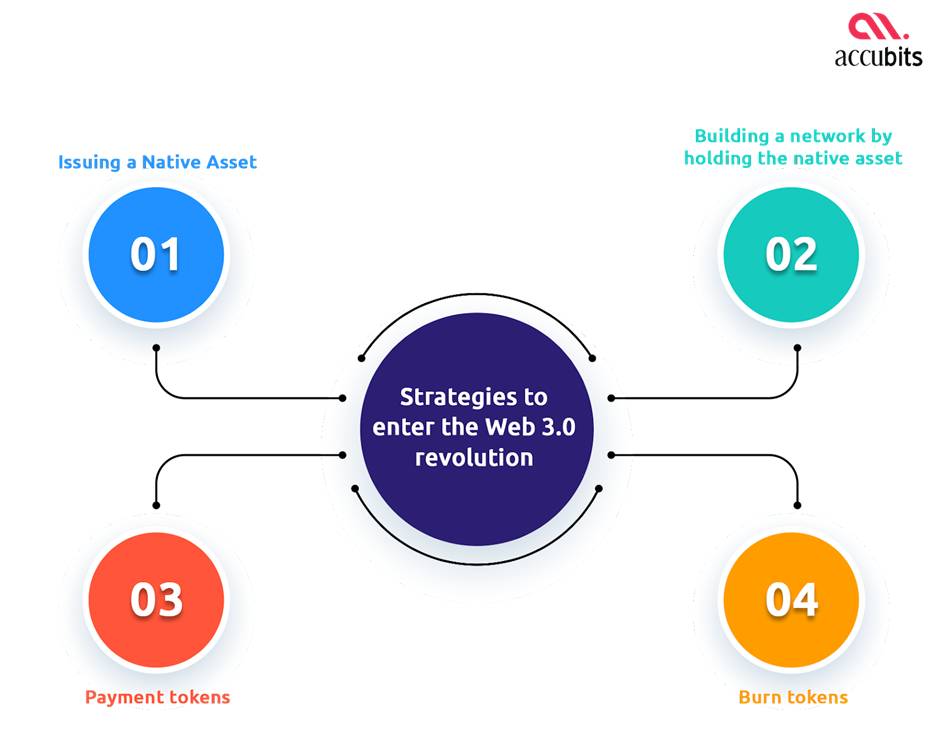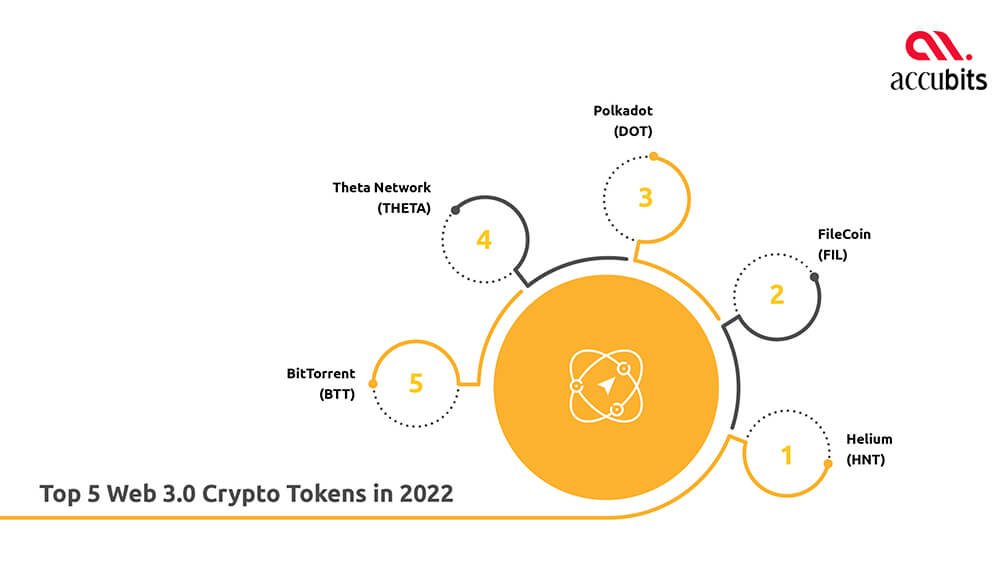Web 3.0—the internet of the future is being facilitated by cryptocurrencies and decentralized blockchain networks. In fact, Web 3.0 crypto tokens have taken the crypto world by storm. They’re changing how the internet works with their ambitious vision and a super-inclusive incentive model.
This article briefly shares all you need to know about this up-and-coming crypto trend of 2022.
- What is Web 3.0?
- What is a Web 3.0 crypto token?
- How does Web 3.0 change the reality of crypto investment?
- How to get your brand ready for the Web 3.0 revolution?
- Top 5 Web 3.0 crypto tokens to watch out for in 2022
- Closing thoughts
What is Web 3.0?
Web 3.0, also known as Web3 or decentralized web, is a proposed evolved state of the world wide web-based on decentralization and using blockchain technology to distribute power equally among users.
Unlike Web 1.0 and Web 2.0, it does not rely on central authorities or servers. Rather Web 3.0 stores data across millions of computers worldwide using blockchain technology that users can access via encrypted links.
Web 3.0 does not require ‘permission.’ That is to say, no central authority decides who gets access to what services. It also does not require ‘trust,’ i.e., no intermediary is needed for virtual transactions to occur between two or more parties.
Decentralized Finance (DeFi) is a component of Web 3.0 that’s gaining popularity. It entails carrying out real-world financial transactions on the blockchain without the help of banks or the government.
Related article: What is DeFi 2.0, and why does it matter?
What is a Web 3.0 crypto token?
Web 3.0 crypto tokens are decentralized projects that use smart contracts and automate transactions over the internet. They are essentially digital assets associated with the vision of creating a decentralized internet. These are monetary incentives offered to anyone who wishes to help create, govern, contribute to, or improve one or more of the Web 3.0 projects.
These Web 3.0 crypto token projects can be the providers of any service such as computation, storage, bandwidth, hosting, identification, etc. For instance, a protocol may provide a marketplace for video infrastructure providers and streaming applications. Another may reward consumers or small businesses for supplying and confirming wireless coverage and sending device data through the network with the help of blockchains and tokens.
These tokens can be digital (crypto) currencies, NFTs, or other blockchain entities.
Related Article: What is Web 3.0 and why does it matter for a business?
How does Web 3.0 change the reality of crypto investment?
Unlike the current infrastructure in Web 3.0, the focus of attention will be on those who offer the best technology for the growth of the Web 3.0 ecosystem. For example, Ethereum, a popular crypto-token, owing to its significant role in helping developers with dApps, may become a long-term investment target for crypto investors.
Similarly, any blockchain protocol that offers an edge over the others to make Web 3.0 a reality will receive the center of attention for investors irrespective of how big or small a name it has.
Web 3.0 paved the way for a wide variety of Web 3.0 crypto tokens. If you plan to launch a Web 3.0 crypto-token, consult with a reliable blockchain development company to do a feasibility analysis.
Related Article: Blockchain as a Service (BaaS): How to choose the right provider?
How to get your brand ready for the Web 3.0 revolution?
The early-stage uses of Web 3.0 are already thriving, and it is just the right time for businesses to understand all that comprises the next era of computers.

Take a look at the below-mentioned points that brands can use to enter into the Web 3.0 revolution:
- Issuing a native asset: While dealing with Web 3.0 crypto tokens, native assets are needed for the smooth operation of a network. These assets derive their value from the security they provide. That is to say, by giving a justifiably high incentive to miners for providing hashing power, the cost of malicious acts rises in correspondence to the price of the native asset. The added security will further drive the demand for the currency, hiking its price and value.
- Building a network by holding the native asset: Brands can adopt the “grow the native asset treasury; build the ecosystem” business model to boost the worth of the native asset they hold. A good example is how Blockstream relies on its bitcoin balance sheet to generate value.
- Payment tokens: Assumptions surrounding the new waves of blockchain initiatives is that as the network’s economy grows, the demand for the restricted native payment token will increase, leading to a rise in the token’s value.
- Burn tokens: Projects may repurchase native tokens from the public market and burn them with flowing revenue, resulting in a decreased supply and an increased price of these Web 3.0 crypto tokens.
Related article on: How to build a metaverse virtual world?
Top 5 Web 3.0 crypto tokens to watch out for in 2022

1. Helium (HNT)
Helium (HNT) is a decentralized blockchain-powered network for IoT devices utilizing a global network of low-energy wireless hotspots to broadcast data using radio waves to be recorded on the blockchain.
The Helium mainnet allows low-powered wireless devices to communicate with each other and send data across its network of nodes. In addition, these nodes come in hotspots and combine a wireless gateway and a blockchain mining device. Users who operate these nodes can mine and earn rewards in HNT. Moreover, its current market capitalization is $3.3 billion, with a value of #31.45 per coin.
2. FileCoin (FIL)
FileCoin (FIL) is a decentralized storage network serving as a secure alternative to centralized cloud storage. Also, it can store almost any data type, including audio, videos, still images, and text.
It is a popular Web 3.0 crypto token that allows users to rent unused hard disk space and earn FIL tokens. With FileCoin, anyone can rent out storage space and buy storage on the network. That is to say; instead of trusting one company with all the important data, it can be split up and stored on different computers around the world.FileCoin has a market capitalization of $4.2 billion with $28.21 per coin.
3. Polkadot (DOT)
Polkadot (DOT) is a protocol that connects blockchains and allows any data to be sent across previously incompatible networks. It is the 10th biggest cryptocurrency with a market capitalization of $24 billion and a value of $24.36 per coin.
In addition, it has a main chain built as its Layer 0, and the parallel chains built as Layer 1 blockchains are connected to the main chain to provide scalability. These also connect to other blockchains with the help of bridges.
4. Theta Network (THETA)
Theta Network (THETA) is a purpose-built decentralized video delivery network that provides technical and financial solutions to the problems currently faced by the streaming sector.
It is a P2P network enabling free, high-bandwidth content delivery. As users watch videos, a part of their computing power is harnessed to relay those videos to other users in the network. The primary user earns THETA tokens as a reward for this.
It is currently the 40th biggest cryptocurrency with a market capitalization of $4 billion and a value of $4.01 per coin.
5. BitTorrent (BTT)
BitTorrent (BTT) is a peer-to-peer protocol for transferring large files over the internet. File types that can be transferred using BitTorrent include TV shows, films, video games, programs, documents, etc.
Moreover, this protocol divides large files into tiny pieces. Each user on the network downloads one such piece and then distributes it to the other users. This file exchange occurs parallel between all the users and does not involve the server’s participation. Therefore, the speed depends on the number of users who download and share the file.
BitTorrent currently has a $2.4 billion market capitalization with $0.002483 per coin.
Related article on: What to know before implementing blockchain in your business
Closing thoughts
Blockchain technology has transcended every sector, from banking and networking to finance, education and healthcare. While most of the global populace is trying to invent new ways to invest in blockchain and crypto, Web 3.0 will emerge as the cornerstone of something bigger than the tech industry ever imagined.
The most appreciated feature of blockchain technology is decentralization. Web 3.0 is an emerging digital breed that aspires to be a decentralized version of the virtual world. Users can dynamically communicate and collaborate via this network without bothering about central and data-specific repositories. Web 3.0 tokens seek transparency, and users will have access to an infinite amount of resources, content, and agreements. Its early applications are already close to completion, and it won’t be long until it spreads its wings into the mainstream.


